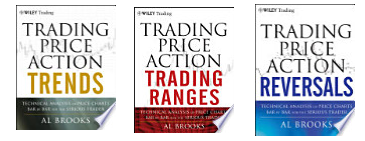The support forum is built with (1) General and FAQ forums for common trading queries received from aspiring and experienced traders, and (2) forums for course video topics. How to Trade Price Action and How to Trade Forex Price Action videos are consolidated into common forums.
Brooks Trading Course social media communities
From article "Becoming a Professional PA Trader" By Ali Moin-Afshari , on BTC website:
"The right strategies feel fun and effortless. Take a few of those and work on becoming an expert in executing them well."
How many different strategies are there? What are they? I thought it was only swing or scalp.
Apart from swing & scalp, how many other strategies are there?
Well I'm a rookie but what I understood is there are countless different strategies, and they all are either a swing- or scalping strategy. A scalp simply means it's a short-term strategie and a swing is a long(er)-term strategy.
Hey W…
“Swing” or “Scalp” aren’t really strategies. They refer to the amount of profit you expect to get from a trade. In a swing you’re looking for at least couple of legs (swings), and for a scalp you’re looking for a few points. Swings tend to give you a good risk reward, for low-medium probability and scalps give you bad risk-reward for high-probability.
“Strategy” isn’t a word Al Brooks uses a lot it is more a word in the Dictionary of a Systems developer like Ali Moin Afshari. But you can think of Al’s methods in terms of strategies.
To make a complete strategy you’d need an entry method. For example, some bull cases:
- Buying a two legged pullback (H2/BullFlag)
- Buying an H1 with a good signal bar
- Buying at the market during a rapid move/surprise bar forming
- Buying a bearish bar at the market in a strong bull trend
- Buying closes at market
- Buying below a trading range (limit order or stop order above failed breakout signal bar)
- Buying in the bottom third of a trading range after a two-legged move down.
- Buying at the bottom of a bull channel (limit order or stop order above a signal bar)
- Buying a breakout of a prior swing high
- Buying a test of the moving average
- Etc etc -- there are hundreds of others covered in Al’s teachings.
You also need a target strategy for example, some bull cases:
- A fixed Risk/Reward target
- A fixed number of points target
- Price action target:
- Top third of trading range,
- X points above a new swing high,
- X points above a channel line
- Measured move target
- etc
You also need a stop strategy for example, some bull cases:
- Bar stop: below signal bar
- Price action Stop:
- Swing stop: below prior major swing
- X Points below a trading range, or trendline
- Measured move stop
- Risk-reward stop if target is known)
- Etc
You may also have a trade management strategy, for example when to exit prematurely (bull cases):
- A wedge top, or other reversal pattern forms
- A huge bull trend bar forms (unexpected profit, a gift) – usually exhaustive
- Running out of time on the day
- Went sideways too long
- Original Premise invalidated
There are other aspects to a strategy:
- Where do you take partial profits?
- Where do you add to your positions?
When you combine all these various aspects you have a complete strategy. All of us think in these terms and we all make these choices when we trade. But only a systems developer would lump all of these things together an think of it as “a strategy”.
Great post.
I title this a Trading Plan (the components thereof).
I think its worthy of a separate course video.
In fact, it wouldn't hurt to restructure the whole course into something like 'Building a Trading Plan'. This would make the course more of a building process, which might make the course more enjoyable. This way, as students work through the course they can feel like they're working towards building their own trading plan, which they will continue to refine as time goes on.

